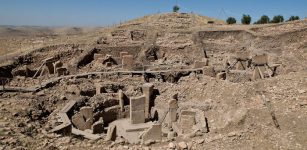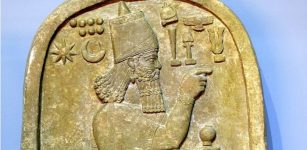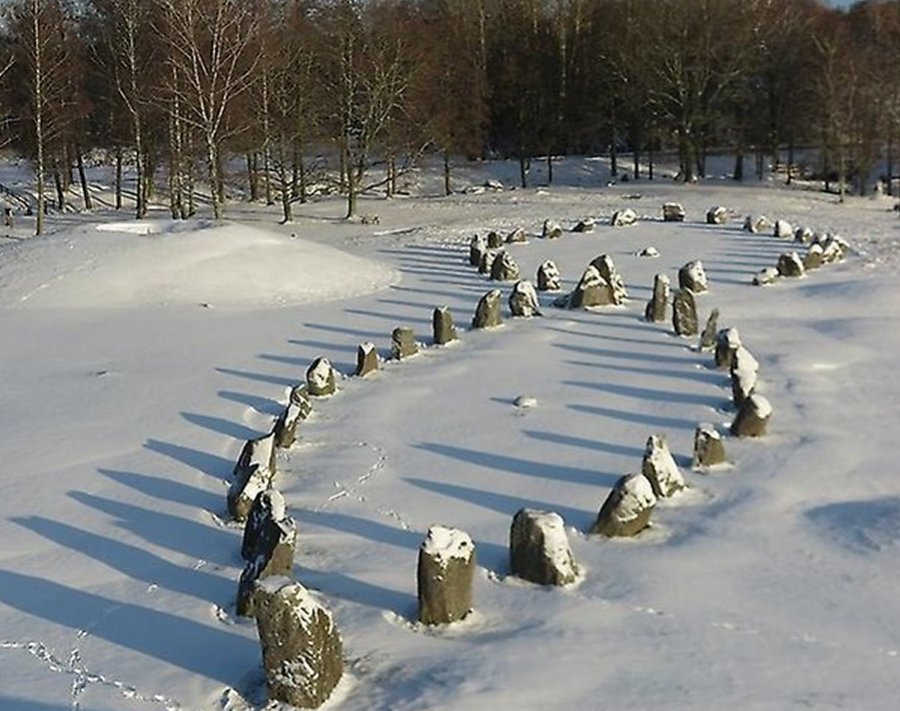Anundshög Burial Mound: One Of Sweden’s Richest And Largest Sacred Ancient Sites
A. Sutherland - AncientPages.com - Anundshög is a burial mound from about 500-700 AD; it is 9 meters (30 ft) high and 60 meters (200 ft) wide, and this is the largest burial mound in Sweden.
Anundshög, located near Västerås in Västmanland, Sweden, contains 12 mounds, ten stone circles, 14 standing stones, and one imposing rune stone. There are also five stone ships of various sizes, the largest of which is 53 meters long and 16 meters wide, in the vicinity of the mound.
Image credit: Anundshög
Many believe the area was a significant center of royal power during the Iron Age and was also important around the 1300s. Anundshög was a part of Eric Street (in Swedish: 'Eriksgata'), and several of the stones in the area mark this traditional path through which the chosen king rode past with his escort to get his royal power confirmed by the people.
Many people participated in the building of the Anundshög burial mound in Sweden. It was made of clay and used to burn the dead, whose remains were covered with a cairn of stones, turf, and soil. The remains around Anundshög clearly show that the area was the core of a prestigious power center during the Iron Age.
Although the site contains many graves, people report the positive energies of the place and several healing areas (one of them is the stone ship).
It seems that in early medieval times, someone deliberately tried to wipe out the power center and weaken its importance. The stone ships were destroyed, and a runestone was overthrown.
The original name of the site is not preserved and remains unknown. During the Middle Ages, the site's name was replaced, and since then, all know it as 'Anundshög.'
Left: The runestone at Anundshög has a pattern and a runic inscription, different from other runes in Sweden. Image credit: www.anundshog.se Right: Image credit: Christer Johansson - CC BY-SA 2.5
Were the burial mound and its name associated with the legendary Swedish king Anund ('trail-blazer) Bröt-Anund or 'Anund the Land Clearer' who reigned during the early 600s, or did the name originate from the large runestone at the site?
Anundshög site has 11 smaller burial mounds, most of which were looted a long time ago; there are also ten stone circles between 6 to 30 meters in diameter.
The damage to the site during the 1600s could be related to the advent of Christianity when similar sites were no longer accepted.
Researchers restored four of the five ships, and the fifth ship setting is still to recover.
"Folkvid raised all of these stones after his son Heden, Anund's brother. Vred carved the runes..."
The runestone at Anundshög has a pattern and a runic inscription, different from other runes in Sweden.
"Folkvid raised all of these stones after his son Heden, Anund's brother. Vred carved the runes..."
A man named Folkvid ordered the construction of the stone ships in the 1000s and helped to construct them.
In the middle of the runestone, a man and a woman are depicted, and according to the inscription:
+ fulkuiþr + raisti + stainn + þasi + ala + at + sun + + sin + hiþin + bruþur + anutaR + uraiþr hik + runaR
The runestone was overturned and moss-grown back in the 1660s, according to Runic Inscriptions 'Ransakningarna' 1667.
Tibble maze, used for all kinds of rites and dated to 100's, is located only 800 meters from Anundshög; formed of 2000-3000 stone, it represents one of Sweden's labyrinths, usually used in fertility rituals or to contact the spirit world with the help of shamans, or medicine men.
Written by – A. Sutherland AncientPages.com Staff Writer
Updated on January 27, 2023
Copyright © AncientPages.com All rights reserved. This material may not be published, broadcast, rewritten or redistributed in whole or part without the express written permission of AncientPages.com
Expand for referencesMore From Ancient Pages
-
 Madame de Pompadour – Powerful And Hated Mistress – Sex, Manipulation And Intrigue In Versailles
Featured Stories | Jul 12, 2018
Madame de Pompadour – Powerful And Hated Mistress – Sex, Manipulation And Intrigue In Versailles
Featured Stories | Jul 12, 2018 -
 Did First Settlers From Asia Reached America By ‘Stepping Stone’ Migration Across Bering Sea?
Archaeology | Apr 30, 2021
Did First Settlers From Asia Reached America By ‘Stepping Stone’ Migration Across Bering Sea?
Archaeology | Apr 30, 2021 -
 Handshaking Is An Ancient Tradition – When, Where And Why Did We Start To Clasp Hands?
Ancient History Facts | Aug 30, 2019
Handshaking Is An Ancient Tradition – When, Where And Why Did We Start To Clasp Hands?
Ancient History Facts | Aug 30, 2019 -
 Could Shipworms Be Destroying The Wreck Of Captain Cook’s Endeavour?
Archaeology | Aug 18, 2022
Could Shipworms Be Destroying The Wreck Of Captain Cook’s Endeavour?
Archaeology | Aug 18, 2022 -
 Stunning Reconstructions Shows What Colchester Looked Like During Roman Times
News | Jul 2, 2022
Stunning Reconstructions Shows What Colchester Looked Like During Roman Times
News | Jul 2, 2022 -
 Ancient Egyptians Observed Algol’s Eclipses – Cairo Calendar Analyzed
Archaeology | Dec 19, 2015
Ancient Egyptians Observed Algol’s Eclipses – Cairo Calendar Analyzed
Archaeology | Dec 19, 2015 -
 This Is The Mysterious Hilltop Where Civilization Began Scientists Say
Archaeology | Jun 24, 2022
This Is The Mysterious Hilltop Where Civilization Began Scientists Say
Archaeology | Jun 24, 2022 -
 Unusual Relic That Mysteriously Disappeared From The Vatican
Ancient Mysteries | Nov 8, 2018
Unusual Relic That Mysteriously Disappeared From The Vatican
Ancient Mysteries | Nov 8, 2018 -
 Stele Of Tell al-Rimah And Deeds Of Assyrian King Adad-nirari Against Rebellious Kings
Featured Stories | Feb 22, 2022
Stele Of Tell al-Rimah And Deeds Of Assyrian King Adad-nirari Against Rebellious Kings
Featured Stories | Feb 22, 2022 -
 Lost Golden City Of Pharaoh Amenhotep III Discovered In Luxor
Archaeology | Apr 9, 2021
Lost Golden City Of Pharaoh Amenhotep III Discovered In Luxor
Archaeology | Apr 9, 2021 -
 2,700-Year-Old Ceramic Sculpture Of Goddess Found In Aegean Sea
Archaeology | Feb 28, 2017
2,700-Year-Old Ceramic Sculpture Of Goddess Found In Aegean Sea
Archaeology | Feb 28, 2017 -
 2,000 Years Ago Mysterious Foreigner With Unique Ancestry Traveled To Cambridgeshire – Who Was He?
Archaeology | Dec 27, 2023
2,000 Years Ago Mysterious Foreigner With Unique Ancestry Traveled To Cambridgeshire – Who Was He?
Archaeology | Dec 27, 2023 -
 Secret Ancient Powers Of Jade: Sacred Green Healing Stone That Can Conquer Time And Guarantee Immortality
Artifacts | Oct 1, 2016
Secret Ancient Powers Of Jade: Sacred Green Healing Stone That Can Conquer Time And Guarantee Immortality
Artifacts | Oct 1, 2016 -
 Numa Pompilius – Remarkable Legendary Second King Of Ancient Rome Who Succeeded Romulus – Did He Ever Exist?
Featured Stories | Mar 2, 2018
Numa Pompilius – Remarkable Legendary Second King Of Ancient Rome Who Succeeded Romulus – Did He Ever Exist?
Featured Stories | Mar 2, 2018 -
 Mother, Father, Child, Marriage And Divorce In Viking Society
Ancient History Facts | Apr 27, 2020
Mother, Father, Child, Marriage And Divorce In Viking Society
Ancient History Facts | Apr 27, 2020 -
 Teotihuacán: Enigmatic Birthplace Of The Gods And Its Obscure History
Civilizations | Jul 26, 2016
Teotihuacán: Enigmatic Birthplace Of The Gods And Its Obscure History
Civilizations | Jul 26, 2016 -
 Depictions Of Two Biblical Heroines Unearthed In Ancient Synagogue, Huqoq In Galilee, Israel
Archaeology | Aug 24, 2022
Depictions Of Two Biblical Heroines Unearthed In Ancient Synagogue, Huqoq In Galilee, Israel
Archaeology | Aug 24, 2022 -
 Brain Development Differs Between Neanderthals And Modern Humans – New Study
Archaeology | Sep 5, 2022
Brain Development Differs Between Neanderthals And Modern Humans – New Study
Archaeology | Sep 5, 2022 -
 Red Paint On 1,000-Year-Old Gold Mask From Peru Contains Human Blood Proteins
Archaeology | Nov 1, 2021
Red Paint On 1,000-Year-Old Gold Mask From Peru Contains Human Blood Proteins
Archaeology | Nov 1, 2021 -
 Stikini ‘Man-Owl’ – Sinister Vampiric Monster That Works In Disguise
Featured Stories | Jan 29, 2019
Stikini ‘Man-Owl’ – Sinister Vampiric Monster That Works In Disguise
Featured Stories | Jan 29, 2019



